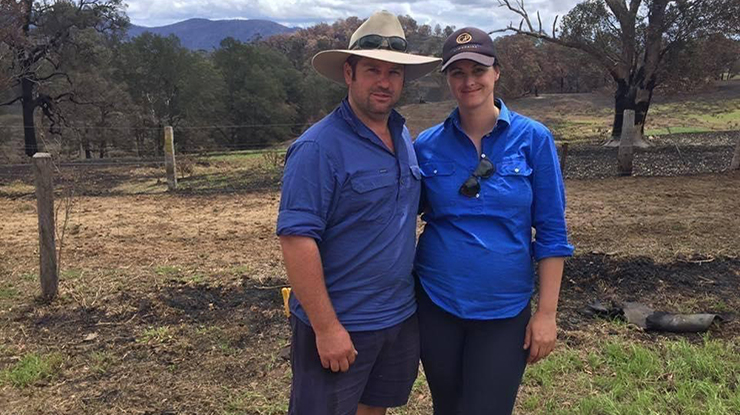
On top against the odds
After persevering through devastating bushfires, NSW beef producers Craig and Tamara Corby know a thing or two about the highs and lows of managing a livestock business.
The Corbys were on the Cobargo property they lease, ‘Belmont Park’, when the 2019 New Year’s Eve bushfires hit the region. They lost 25 stud bulls, pregnant cows, a large portion of their machinery and nearly all their pasture.
Faced with the enormous challenge of rebuilding, Tamara said their first, immediate step was to take a pragmatic approach to recovery.
While it proved crucial to their ability to overcome the adversity, the Corbys acknowledged not everyone may have the capacity to do the same.
“We just tried to make rational decisions in irrational times,” Tamara said.
For example, while an immediate thought might have been to offload stock as there was no pasture, Tamara and Craig paused to consider the implications.
“Craig and I tried to think more laterally about how we could take advantage of the changing industry. Investing in trade cattle ended up being a really good recovery strategy.”
“We thought, we can’t sell our cows, because we’d be selling them for less than what we paid for them. They’re our bread and butter that we’d been feeding through the drought.”
Taking stock
The couple’s quick thinking to put a firebreak around their hayshed before the fire hit meant they had hay on hand and could feed their herd while they considered their next move in the days and weeks following the fire.
“We didn’t have many fences left to contain the cattle, but even if they got out, there was nothing for them to eat as everything had been burnt – so as long as we kept feeding them hay, they just stayed where they were,” Craig said.
The break around the shed also provided a biosecurity benefit, as they didn’t have to deal with weed management issues from introduced feed. When they did access donated hay for additional feed, the Corbys were strategic in where they placed it – such as avoiding water drainage areas to prevent weed incursion.
Getting a hand
The Corbys' fellow Limousin producers rallied around and provided emergency agistment and fodder to the couple immediately after the fires.
“We were very fortunate to have a close-knit Limousin community around us and we got a couple of loads of hay from different breeders, who gave it off their own backs,” Craig said.
“One breeder was so generous they sent a load of hay to us and also took 40 of our cows to continue joining them for us, free of charge.”
Towards a healthy herd
Before they sent livestock off-farm, the Corbys completed a full health inspection on their herd – including checking for burnt udders and pregnancy assessments.
This assessment paid dividends for their recovery.
“It was initially a tough call as to whether we needed that extra expense, but we found that going to the effort of health inspecting every animal individually really helped inform our management decisions moving forward,” Tamara said.
Taking the chance
When their cows were moved, the Corbys turned their focus to the 80 weaners remaining on-farm.
The Corbys yarded the calves and fed them pellets, but the seasonal conditions meant it soon became apparent agistment was the most cost-effective solution to retain their weaners.
“Post the drought, there was cheap agistment because many people had sold cattle, and we got agistment for them in western NSW,” Craig said.
Capitalising on the conditions to find cost-effective agistment for the weaners also led to an opportunity that has helped fast-track their enterprise’s recovery.
“As time went on and the drought broke, we could see cattle prices were starting to go up – so we took the opportunity to buy some calves and diversify our business by developing a trade operation,” Tamara said.
“Craig and I tried to think more laterally about how we could take advantage of the changing industry. Investing in trade cattle ended up being a really good recovery strategy.”
Onwards and upwards
The Corbys accessed MLA’s ‘Back to Business’ program, which connected fire-affected producers with local farm business consultants, and said it was a significant help as they rebuilt their enterprise.
The Corbys were assigned Alastair Rayner from Rayner Ag as part of the program, who worked through strategies as well as short and long-term goals for their business.
“It gave us a great sense of relief, having a third party who was able to give us clarity and focus on the high-level context to keep us moving forward,” Tamara said.
“He also taught us skills around financial management and marketing that would go beyond the recovery.”
Looking back on 2019, the Corbys are grateful for the support provided by the broader community, which they credit as essential in helping them get back to business – especially Need for Feed, BlazeAid, the Army, South Coast Rural Relief and Local Land Services.
“It’s these first responders to communities who really make a difference – the early intervention is such a relief and it’s so important that the deployment of services is really quick,” Tamara said.
|
LESSONS LEARNT
|
|
Creating a carbon account: a checklist Collect data on your:
|



